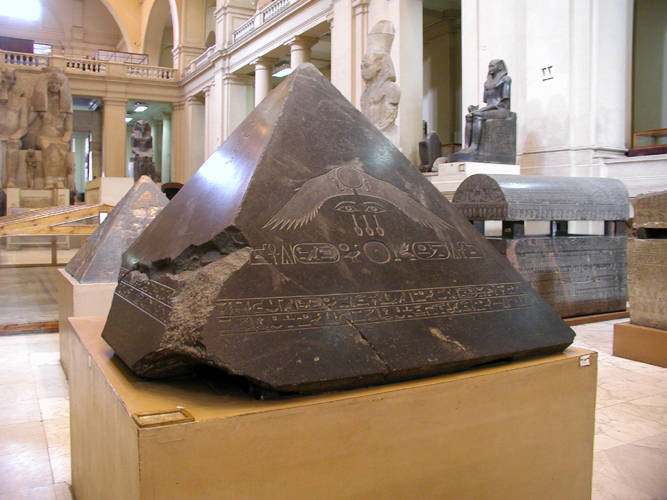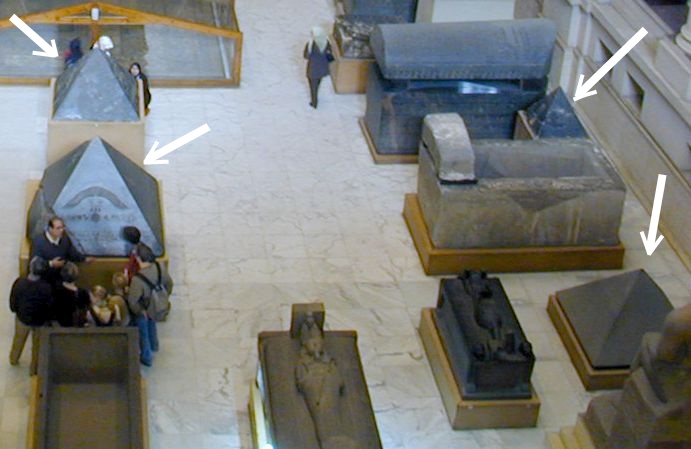pyramidion on:
[Wikipedia]
[Google]
[Amazon]
 A pyramidion (plural: pyramidia) is the capstone of an Egyptian pyramid or the upper section of an
A pyramidion (plural: pyramidia) is the capstone of an Egyptian pyramid or the upper section of an

 A badly damaged white Tura limestone pyramidion, thought to have been made for the Red Pyramid of Sneferu at Dahshur, has been reconstructed and is on open-air display beside that pyramid; it presents a minor mystery, however, as its angle of inclination is steeper than that of the edifice it was apparently built to surmount.
A badly damaged white Tura limestone pyramidion, thought to have been made for the Red Pyramid of Sneferu at Dahshur, has been reconstructed and is on open-air display beside that pyramid; it presents a minor mystery, however, as its angle of inclination is steeper than that of the edifice it was apparently built to surmount.
File:Pyramidion of Nesnubhotep, top of a limestone chapel monument. A scarab and adoring baboons in relief. 26th Dynasty. From Abydos, Egypt. The Petrie Museum of Egyptian Archaeology, London.jpg, Pyramidion of the chapel of Nesnubhotep, limestone with relief of a scarab and adoring baboons, 26th Dynasty, Abydos
File:Pyramidion of Nebamun. Possibly top of a stela. Limestone. 19th Dynasty. From Egypt. Bought in the Thebaid (Thebais) but probably it came from Deir el-Medina. The Petrie Museum of Egyptian Archaeology, London.jpg, Pyramidion of Nebamun, limestone, 19th Dynasty, probably from
 A pyramidion (plural: pyramidia) is the capstone of an Egyptian pyramid or the upper section of an
A pyramidion (plural: pyramidia) is the capstone of an Egyptian pyramid or the upper section of an obelisk
An obelisk (; , diminutive of (') ' spit, nail, pointed pillar') is a tall, slender, tapered monument with four sides and a pyramidal or pyramidion top. Originally constructed by Ancient Egyptians and called ''tekhenu'', the Greeks used th ...
. Speakers of the Ancient Egyptian language referred to pyramidia as ''benbenet'' and associated the pyramid as a whole with the sacred benben stone.Toby Wilkinson, ''The Thames and Hudson Dictionary of Ancient Egypt'', Thames & Hudson, 2005. p. 197
Pyramidia were usually made of limestone
Limestone is a type of carbonate rock, carbonate sedimentary rock which is the main source of the material Lime (material), lime. It is composed mostly of the minerals calcite and aragonite, which are different Polymorphism (materials science) ...
, sandstone
Sandstone is a Clastic rock#Sedimentary clastic rocks, clastic sedimentary rock composed mainly of grain size, sand-sized (0.0625 to 2 mm) silicate mineral, silicate grains, Cementation (geology), cemented together by another mineral. Sand ...
, basalt
Basalt (; ) is an aphanite, aphanitic (fine-grained) extrusive igneous rock formed from the rapid cooling of low-viscosity lava rich in magnesium and iron (mafic lava) exposed at or very near the planetary surface, surface of a terrestrial ...
or granite
Granite ( ) is a coarse-grained (phanerite, phaneritic) intrusive rock, intrusive igneous rock composed mostly of quartz, alkali feldspar, and plagioclase. It forms from magma with a high content of silica and alkali metal oxides that slowly coo ...
, and were sometimes covered with plates of copper, gold
Gold is a chemical element; it has chemical symbol Au (from Latin ) and atomic number 79. In its pure form, it is a brightness, bright, slightly orange-yellow, dense, soft, malleable, and ductile metal. Chemically, gold is a transition metal ...
or electrum
Electrum is a naturally occurring alloy of gold and silver, with trace amounts of copper and other metals. Its color ranges from pale to bright yellow, depending on the proportions of gold and silver. It has been produced artificially and is ...
. From the Middle Kingdom onward, they were often "inscribed with royal titles and religious symbols".
Notable pyramidia

Egyptian Museum
Four pyramidia are housed in the main hall of theEgyptian Museum
The Museum of Egyptian Antiquities, commonly known as the Egyptian Museum (, Egyptian Arabic: ) (also called the Cairo Museum), located in Cairo, Egypt, houses the largest collection of Ancient Egypt, Egyptian antiquities in the world. It hou ...
in Cairo
Cairo ( ; , ) is the Capital city, capital and largest city of Egypt and the Cairo Governorate, being home to more than 10 million people. It is also part of the List of urban agglomerations in Africa, largest urban agglomeration in Africa, L ...
:
* The pyramidion of the so-called Black Pyramid of Amenemhat III at Dahshur
DahshurAlso transliterated ''Dahshour'' (in English often called ''Dashur''; ' ) is an ancient Egyptian pyramid complex and necropolis and shares the name of the nearby village of Manshiyyat Dahshur () in markaz Badrashin, Giza Governorate, Giza ...
editors Regine Schulz and Matthias Seidel (w/34 contributing Authors), ''Egypt, The World of the Pharaohs,'' Konemann, Germany: 1998. '' Amenemhat III'', 1842–1797 BC p. 115
* The pyramidion of the Pyramid of Khendjer at Saqqara
* The pyramidion of Merneferre Ay, probably from Saqqara
* The pyramidion of the Southern South Saqqara pyramid
Red Pyramid
 A badly damaged white Tura limestone pyramidion, thought to have been made for the Red Pyramid of Sneferu at Dahshur, has been reconstructed and is on open-air display beside that pyramid; it presents a minor mystery, however, as its angle of inclination is steeper than that of the edifice it was apparently built to surmount.
A badly damaged white Tura limestone pyramidion, thought to have been made for the Red Pyramid of Sneferu at Dahshur, has been reconstructed and is on open-air display beside that pyramid; it presents a minor mystery, however, as its angle of inclination is steeper than that of the edifice it was apparently built to surmount.
Washington Monument
Erected in 1876 in Washington D.C., theWashington Monument
The Washington Monument is an obelisk on the National Mall in Washington, D.C., built to commemorate George Washington, a Founding Fathers of the United States, Founding Father of the United States, victorious commander-in-chief of the Continen ...
holds an inscribed pyramidion of aluminum.
Private brick pyramids with pyramidia
During the New Kingdom, some private underground tombs were marked on the surface by small brick pyramids that terminated in pyramidia. The four lateral sides included texts and scenes related to the cult of the Sun God (as the representation ofPharaoh
Pharaoh (, ; Egyptian language, Egyptian: ''wikt:pr ꜥꜣ, pr ꜥꜣ''; Meroitic language, Meroitic: 𐦲𐦤𐦧, ; Biblical Hebrew: ''Parʿō'') was the title of the monarch of ancient Egypt from the First Dynasty of Egypt, First Dynasty ( ...
).
The scenes typically depict the course of the sun, rising on one lateral face, setting on the opposite face, and traveling, through the night, through the underworld, ruled by Osiris
Osiris (, from Egyptian ''wikt:wsjr, wsjr'') was the ancient Egyptian deities, god of fertility, agriculture, the Ancient Egyptian religion#Afterlife, afterlife, the dead, resurrection, life, and vegetation in ancient Egyptian religion. He was ...
.
Scribe Mose pyramidion
The pyramidion of Mose ( mes,s, New Kingdom, 19th Dynasty, , limestone, 53 cm tall) depicts himself making an offering, with his name on two opposite faces. The adjacent opposite faces feature a baboon: "Screeching upon the rising of the Sun, and the Day". (The baboon is also the god-scribe representation of theScribe
A scribe is a person who serves as a professional copyist, especially one who made copies of manuscripts before the invention of Printing press, automatic printing.
The work of scribes can involve copying manuscripts and other texts as well as ...
, for the god Thoth.)Peck, William. ''Splendors of Ancient Egypt,'' William H. Peck, The Detroit Institute of Arts, (University Lithoprinters Inc., Ann Arbor, Mich.), c. 1997, (p. 67). (''Moses Pyramidion'' from "Roemer and Pelizaeus Museum, Hildesheim, Germany".)
Ptahemwia pyramidion
The pyramidion of Ptahemwia (19th Dynasty, Ramesside Period, , ''limestone'', 28 cm wide, 42 cm tall) likewise displays sun-related scenes. The Sun God, Re-Horakhti, and the god of the Underworld,Osiris
Osiris (, from Egyptian ''wikt:wsjr, wsjr'') was the ancient Egyptian deities, god of fertility, agriculture, the Ancient Egyptian religion#Afterlife, afterlife, the dead, resurrection, life, and vegetation in ancient Egyptian religion. He was ...
, are shown on one lateral face.
Facing the two gods, on the adjacent lateral face, is the deceased Ptahemwia, standing in an offering pose, facing three columns of hieroglyphs.
Gallery
Deir el-Medina
Deir el-Medina (), or Dayr al-Madīnah, is an ancient Egyptian workmen's village which was home to the artisans who worked on the tombs in the Valley of the Kings during the 18th to 20th Dynasties of the New Kingdom of Egypt (ca. 1550–1080 BC). ...
File:PyramidionFromPrivateTomb RosicrucianMuseum.png, Private tomb limestone pyramidion, at the Rosicrucian Egyptian Museum
File:Pyramidion from the tomb of Rer (7th century BCE).jpg, Pyramidion from the tomb of the priest Rer in Abydos, Egypt. Hermitage Museum
The State Hermitage Museum ( rus, Государственный Эрмитаж, r=Gosudarstvennyj Ermitaž, p=ɡəsʊˈdarstvʲɪn(ː)ɨj ɪrmʲɪˈtaʂ, links=no) is a museum of art and culture in Saint Petersburg, Russia, and holds the large ...
File:Pyramidion di Ramose PAP8834-HDR.tif, Pyramidion of Ramose, from Deir el-Medina
Deir el-Medina (), or Dayr al-Madīnah, is an ancient Egyptian workmen's village which was home to the artisans who worked on the tombs in the Valley of the Kings during the 18th to 20th Dynasties of the New Kingdom of Egypt (ca. 1550–1080 BC). ...
, 1292–1190 BC ( New Kingdom), limestone, Museo Egizio, Turin
See also
*Washington Monument
The Washington Monument is an obelisk on the National Mall in Washington, D.C., built to commemorate George Washington, a Founding Fathers of the United States, Founding Father of the United States, victorious commander-in-chief of the Continen ...
, which has an aluminum pyramidion
References
External links
{{Authority control Ancient Egyptian pyramids Architectural elements Egyptian artefact types Sacred rocks